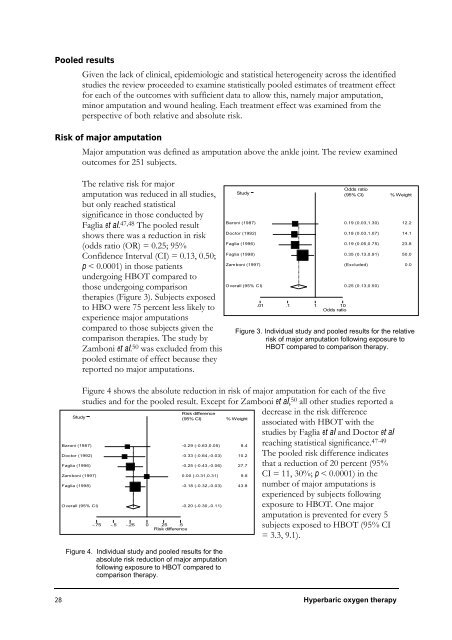Hyperbaric Oxygen Therapy - Hyperbaric Chamber Information ...
Hyperbaric Oxygen Therapy - Hyperbaric Chamber Information ...
Hyperbaric Oxygen Therapy - Hyperbaric Chamber Information ...
You also want an ePaper? Increase the reach of your titles
YUMPU automatically turns print PDFs into web optimized ePapers that Google loves.
Pooled results<br />
Given the lack of clinical, epidemiologic and statistical heterogeneity across the identified<br />
studies the review proceeded to examine statistically pooled estimates of treatment effect<br />
for each of the outcomes with sufficient data to allow this, namely major amputation,<br />
minor amputation and wound healing. Each treatment effect was examined from the<br />
perspective of both relative and absolute risk.<br />
Risk of major amputation<br />
Major amputation was defined as amputation above the ankle joint. The review examined<br />
outcomes for 251 subjects.<br />
Study<br />
-.75 -.5 -.25 0 .25 .5<br />
Risk difference<br />
Risk difference<br />
(95% CI)<br />
.01 .1 1 10<br />
Odds ratio<br />
Figure 3. Individual study and pooled results for the relative<br />
risk of major amputation following exposure to<br />
HBOT compared to comparison therapy.<br />
28 <strong>Hyperbaric</strong> oxygen therapy<br />
Study<br />
Odds ratio<br />
(95% CI)<br />
% Weight<br />
Baroni (1987) 0.19 (0.03,1.30) 12.2<br />
Doctor (1992) 0.18 (0.03,1.07) 14.1<br />
Faglia (1996) 0.19 (0.05,0.75) 23.8<br />
Faglia (1998) 0.35 (0.13,0.91) 50.0<br />
Zamboni (1997) (Excluded)<br />
0.0<br />
Overall (95% CI)<br />
% Weight<br />
Baroni (1987) -0.29 (-0.63,0.05) 8.4<br />
Doctor (1992) -0.33 (-0.64,-0.03) 10.2<br />
Faglia (1996) -0.25 (-0.43,-0.06) 27.7<br />
Zamboni (1997) 0.00 (-0.31,0.31) 9.8<br />
Faglia (1998) -0.18 (-0.32,-0.03) 43.8<br />
Overall (95% CI)<br />
The relative risk for major<br />
amputation was reduced in all studies,<br />
but only reached statistical<br />
significance in those conducted by<br />
Faglia et al. 47,48 The pooled result<br />
shows there was a reduction in risk<br />
(odds ratio (OR) = 0.25; 95%<br />
Confidence Interval (CI) = 0.13, 0.50;<br />
p < 0.0001) in those patients<br />
undergoing HBOT compared to<br />
those undergoing comparison<br />
therapies (Figure 3). Subjects exposed<br />
to HBO were 75 percent less likely to<br />
experience major amputations<br />
compared to those subjects given the<br />
comparison therapies. The study by<br />
Zamboni et al. 50 was excluded from this<br />
pooled estimate of effect because they<br />
reported no major amputations.<br />
-0.20 (-0.30,-0.11)<br />
Figure 4. Individual study and pooled results for the<br />
absolute risk reduction of major amputation<br />
following exposure to HBOT compared to<br />
comparison therapy.<br />
0.25 (0.13,0.50)<br />
Figure 4 shows the absolute reduction in risk of major amputation for each of the five<br />
studies and for the pooled result. Except for Zamboni et al, 50 all other studies reported a<br />
decrease in the risk difference<br />
associated with HBOT with the<br />
studies by Faglia et al and Doctor et al<br />
reaching statistical significance. 47-49<br />
The pooled risk difference indicates<br />
that a reduction of 20 percent (95%<br />
CI = 11, 30%; p < 0.0001) in the<br />
number of major amputations is<br />
experienced by subjects following<br />
exposure to HBOT. One major<br />
amputation is prevented for every 5<br />
subjects exposed to HBOT (95% CI<br />
= 3.3, 9.1).



